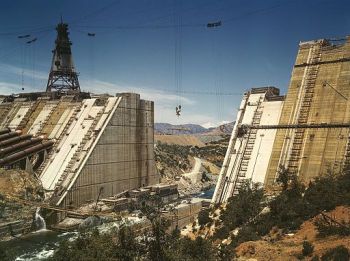New Dams: Difference between revisions
From ASDSO Dam Safety Toolbox
No edit summary |
Rmanwaring (talk | contribs) No edit summary |
||
| Line 23: | Line 23: | ||
* [[Environmental]] Impact Studies | * [[Environmental]] Impact Studies | ||
* [[Sedimentation| Reservoir Sedimentation Analyses]] | * [[Sedimentation| Reservoir Sedimentation Analyses]] | ||
* Preliminary Site Investigations | * [[Geotechnical Exploration | Preliminary Site Investigations]] | ||
* [[Geotechnical and Geology | Geologic and Geotechnical]] Investigations | * [[Geotechnical and Geology | Geologic and Geotechnical]] Investigations | ||
* [[Seismic]] Investigations | * [[Seismic]] Investigations | ||
Revision as of 18:25, 19 December 2022

|
| Construction of the Shasta Dam in California between 1938 and 1945. |
The planning, design, and construction of a new dam requires many different tasks involving a variety of disciplines. Common tasks include but are not limited to:
- Legal Agreements
- Permitting
- Public Outreach
- Hazard Potential Classification
- Water Demand / Population Studies
- Benefit-Cost Analyses
- Hydrologic Studies
- Environmental Impact Studies
- Reservoir Sedimentation Analyses
- Preliminary Site Investigations
- Geologic and Geotechnical Investigations
- Seismic Investigations
- Structural / Embankment Design
- Hydraulic Design
- Creation of an Operation and Maintenance Program
- Risk Communication
- Construction Management
Best Practices Resources
![]() TR-210-60 Earth Dams and Reservoirs, NRCS, 2019
TR-210-60 Earth Dams and Reservoirs, NRCS, 2019
![]() Design Standards No. 13: Embankment Dams (Ch. 1: General Design Standards), USBR, 2011
Design Standards No. 13: Embankment Dams (Ch. 1: General Design Standards), USBR, 2011
![]() Federal Guidelines for Dam Safety (FEMA P-93), FEMA, 2004
Federal Guidelines for Dam Safety (FEMA P-93), FEMA, 2004
Trainings
![]() On-Demand Webinar: Field Investigations for New and Existing Dams
On-Demand Webinar: Field Investigations for New and Existing Dams
![]() On-Demand Webinar: Risk Assessment Basics for an Individual Dam
On-Demand Webinar: Risk Assessment Basics for an Individual Dam
Citations:
Revision ID: 5978
Revision Date: 12/19/2022
